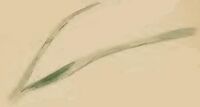Biology:Elachista gangabella
| Elachista gangabella | |
|---|---|

| |
| Scientific classification | |
| Domain: | Eukaryota |
| Kingdom: | Animalia |
| Phylum: | Arthropoda |
| Class: | Insecta |
| Order: | Lepidoptera |
| Family: | Elachistidae |
| Genus: | Elachista |
| Species: | E. gangabella
|
| Binomial name | |
| Elachista gangabella Zeller, 1850[1]
| |
| Synonyms | |
| |
Elachista gangabella is a moth of the family Elachistidae. It is found in all of Europe, except the Iberian Peninsula.
The wingspan is 9–10 millimetres (0.35–0.39 in). The head is blackish-grey.Forewings are blackish ; a straight somewhat inwardly oblique central whitish-yellowish fascia, in male narrowed towards costa ; tips of apical cilia whitish. Hindwings are dark grey.The larva is grey-green, yellowish-tinged ; head yellow-brown ; 2 with two pale brown spots.[2]
Adults are on wing from March to June.[3]
The larvae feed on tor-grass (Brachypodium pinnatum), false-brome (Brachypodium sylvaticum), cock's-foot (Dactylis glomerata) and mountain melick (Melica nutans). They mine the leaves of their host plant. The mine is transparent and generally descends from the leaf tip. A central silken tube stretches over the entire length of the mine which the larva uses to retreat in. The frass is deposited in this tube. Feeding takes place from within the tube.[4] They are greyish white. Larvae can be found from September to November. They then hibernate within the mine. In spring, they leave the mine to pupate.
References
- ↑ "Elachista (Aphelosetia) gangabella Zeller, 1850". https://fauna-eu.org/cdm_dataportal/taxon/6a55262c-8788-40ca-aaf6-0962dc6ba1f0.
- ↑ Meyrick, E., 1895 A Handbook of British Lepidoptera MacMillan, London pdf
 This article incorporates text from this source, which is in the public domain. Keys and description
This article incorporates text from this source, which is in the public domain. Keys and description
- ↑ "microlepidoptera.nl". http://www.microlepidoptera.nl/soorten/species.php?speciescode=250250&p=1.
- ↑ "Elachista gangabella Zeller, 1850". Bladmineerders.nl. http://www.bladmineerders.nl/minersf/lepidopteramin/elachista/gangabella/gangabella.htm.
Wikidata ☰ Q5352740 entry
 |



